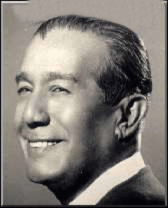9.9 Outstanding conductors of Cuban music in the 20th century (1900-1930).

With the popularity achieved by the orchestras that emerged in these years, we must refer to the conductors who reached the top, to these popular orchestras of Cuban music in the 20th century (1900-1930): Aniceto Díaz, Ignacio Piñeiro and Moisés Simons.
Aniceto Díaz was a flutist, composer, and orchestra conductor, as well as a teacher. In 1902, he replaced his teacher in the Music Band, where he remained for a long time. In 1914, he achieved his greatest desire to form his own traditional orchestra, and they performed for the first time in the halls of the Matanzas Artistic and Literary Lyceum. He performed danzones and North American music that was in vogue at the time.
In 1944, Aniceto settled in Havana and reorganized his orchestra with children and musicians from the capital. He became one of the most distinguished figures in Cuban music.
Ignacio Piñeiro Martínez was born in Havana in 1888. He never stopped assimilating the sounds and songs of the African cabildos that existed in his neighborhood. In 1906, he joined the harpsichord and guaguancó group. He began his artistic career with the harpsichord and guaguancó group El Timbre de Oro as an improvising decimist. He led the well-known group Los Roncos for several years, taking his first steps as a composer.
He was one of the founders of the Western Son Sextet in 1926, under the direction of troubadour María Teresa Vera. In 1927, he founded the National Sextet, was its director, and played the double bass. That same year, he added the trumpet, played by Lázaro Herrera, transforming it into a Septet. As a composer, Ignacio Piñeiro broke away from the oriental son form, although he borrowed elements from it. Its creators used the quartet and the tenth.
Piñeiro managed to capture, develop, and express the full richness of Son. His musical creations involved structural modifications, the use of cadence, rhythm, and the use of refined melodies and lyrics.
Moisés Simón Rodríguez, known as Moisés Simons, was a Cuban composer, pianist, and orchestra conductor. Beginning in 1901, he began directing children’s troupes at the Teatro Martí. By 1906, he had his own orchestra, with which he hosted variety shows at theaters throughout the capital, where he served as both conductor and pianist.
In 1920, he performed with his orchestra at the Baile de los Mantones (Shawl Dance) at the Casino de la Playa; in 1922, he performed at the Havana Yacht Club, where he entertained at the dances. “El manisero” (The Peanut Vendor), his most famous piece, has been performed by various musical groups and singers.
Among his contributions to Cuban music, not counting his compositions, we can mention that as a jazz band orchestra director, during the 1930s, he introduced the Danzón in this type of instrumental format.
Miguel Matamoros, a renowned Cuban guitarist and composer, performed serenades and livened up popular festivals in his hometown neighborhoods with his friends at just 15 years of age. In 1924, he created the Trio Oriental, where he served as director, guitarist, and lead singer. A year later, he founded the Trio Matamoros; he later established other groups such as the Septeto Matamoros. He also recorded Conjunto Matamoros, founded in 1945. With this group, he made more than 100 recordings, some of which featured performances by renowned vocalists such as Benny Moré and Carlos Embale.
The Septeto Matamoros was founded on June 12, 1996, to continue the musical tradition of the Matamoros lineage. This great leader was a gifted singer, capable of playing a high A with ease; as a prima guitarist, he provided introductions and also provided highly distinctive, evocative, and colorful riffs.








